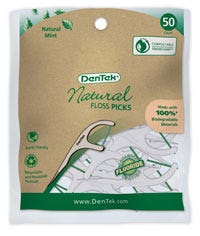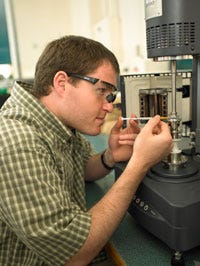With consumers pushing for biodegradable and bio-based products and molders becoming more familiar with processing requirements, biomaterials are finding a wider range of applications.
July 14, 2009
With consumers pushing for biodegradable and bio-based products and molders becoming more familiar with processing requirements, biomaterials are finding a wider range of applications.
In the early years of biomaterials’ presence in the market, it was tough to find many applications that were injection molded, as most of them involved basic packaging. But molded applications began to appear. The subsequent shift from molding more than starch cutlery has happened quickly, and the product portfolios of bio-based and biodegradable options are expanding even more rapidly. The initially limited production capacities of these materials is also growing, with more manufacturing facilities coming online at this writing. The companies that developed these biomaterials are seeking out new applications for their new and improved grades.
|
With more experience on how to process these materials, the material suppliers now are offering product designers information and assistance from concept through manufacturing. Here then are some of the basics of biomaterials, and the not-so-basic applications that utilize their advancing material options.
Tricky terminology
As consumers want and are willing to pay more for bio-based or biodegradable products, an abundance of terms have been spawned to describe a variety of materials on the market. Some of them are legitimate, while others make claims to create the impression of being earth-friendly—a process referred to as “greenwashing.” In 2008, a Bioplastics Council special interest group was formed within the Society of the Plastics Industry (Washington, DC), and its goals for 2009 include providing information on market growth, applications, companies, products made, and production numbers. To clear up any confusing terms, the council developed a terminology guide that was made available at NPE2009 (you can also download it at www.bioplasticscouncil.org).
“Being a new market with new technology, there’s a lot of confusion about it,” says SPI Bioplastics Council chair Bob Findlen, VP of sales and marketing at Telles, a joint venture of Metabolix and Archer Daniels Midland Co. that is commercializing Mirel bioplastics. “As a group, if we educate the market, whether we are competitors or not, it helps all of our businesses. We’re all in agreement on the need for standardizations and specifications. We need standards based on science, not greenwashing. Hopefully we can drive that terminology into the market.”
Generally speaking, biomaterials fall into one of two main categories—bio-based or biodegradable—and sometimes are both. Biodegradable materials break down into water, humus, and carbon dioxide with prolonged exposure to microorganisms. Bio-based materials are derived from renewable biomass sources such as vegetable oil, starch, or microbiota, rather than fossil fuel. There are also blends that can be partially bio-based, which may or may not be biodegradable as well.
In terms of processing bioplastics, there’s a small difference between the melting point of the polymer and the degradation temperature. Unlike polymers that are generally molded at 25 deg C above the melting point temperature, biomaterials have a narrow processing window, and must be heated just beyond the point where the polymer will begin to solidify and crystallize, yet below the degradation point. The ability to control the melt temperature is key for successful processing, as is proper purging to remove traces of any higher-melt-temperature materials. To fill the mold cavity quickly, viscosity must be low, but not too low, as it will flash at the parting line. To determine the proper cooling time, it is best to start with a longer time to ensure the parts will properly eject, and slowly lower the cooling time until ejector pins start to leave marks on the part surface.
This presents several challenges to designers wishing to develop biodegradable or bio-sourced products, but advances in materials and an increasing amount of resources provided by materials companies and other associations can help turn product ideas into reality in a variety of applications.
For example, in order to perform testing, conduct research, and provide resources for customers, NatureWorks (Minnetonka, MN), a joint venture of Cargill and Teijin Ltd. that developed Ingeo polylactic acid (PLA), transformed its former pilot plant into a bioresin applications lab. The lab is used to perform physical testing, chemical composition, rheology, and thermo-analysis, and offers collaborative research relationships with universities and colleges within the area.
“Some of the tasks of the new NatureWorks application lab include developing and testing compounds on commercial machines, moving Ingeo natural plastic into new product areas, demonstrating Ingeo processing characteristics to processors, and working side by side with brand owners to test their product concepts,” says Marc Verbruggen, president and CEO of NatureWorks. “The lab is designed to enable NatureWorks converters and brand owners to bring quality products made from renewable resources to market quickly and effectively.”
When degradation is good
Factors like UV, heat, and stress can damage most petroleum-based plastics over time. The same factors also help the various bio-based polymers break down in landfills, or even in home compost. Nearly 100% of the petroleum-based additives used in traditional plastics are replaced with bio-based material such as corn, wheat, tapioca, and potato starches in Cereplast’s (Hawthorne, CA) Compostables resins, which meet the Biodegradable Products Institute (BPI) standards for compostability (ASTM 6400 D99 and ASTM 6868) and European Bioplastics standards (EN 13432). When placed in an industrial compost facility, products made from the Compostables resins are said to break down in less than 180 days, and a variety of starch options helps keep costs competitive with traditional resins in case there are fluctuations in any one commodity.
Cereplast supplies its Compostables resin for oral care company DenTek’s (Maryville, TN) Natural Floss Picks, the first biodegradable/compostable floss pick on the market, which is said to create approximately one-third less waste, with the handles certified to be 100% compostable by the BPI.
“We developed the Natural Floss Pick based on consumer, customer, and employee feedback, as well as our continuing commitment to creating environmentally friendly oral care products,” says Lex Shankle, DenTek’s VP of marketing. “Cereplast’s bioresins provided us with a way to create this first-if-its-kind green floss pick without sacrificing quality or performance.”
While many biomaterials involve cornstarch, the way it is incorporated into the material makes a big difference in its potential range of applications. Metabolix’s Mirel polyhydroxyalkoanate (PHA) is derived from microbes. Engineered E. coli bacteria, also used in pharmaceuticals, store PHA for energy after consuming cornstarch feedstock. Metabolix has had major successes with certain products made from biomaterials, like gift cards for Target that decompose in soil, landfills, rivers, and oceans. However, the company is still working out of its pilot plant with limited production capabilities until its plant in Clinton, IA opens later this year, offering 110 million lb of annual production and the infrastructure to quadruple that, if necessary.
A biodegradable version of the AquaSphere PRO pond and lake treatment system for golf courses developed by Bioverse (Pipestone, MN) is made out of Mirel. This is Telles’ first customer in the marine and fresh water market, and the submersible, plastic-enclosed water treatment system that will biodegrade in fresh water is the only high-performance thermoplastic certified to meet the Vinçotte OK Biodegradable Water Standard for natural fresh water environments. “The Mirel-made AquaSphere Pro by Bioverse is a breakthrough solution for the treatment of stagnant, contaminated water. Customers want environmentally friendly solutions for water health and clarity, and we are projecting increased sales with our new product,” says Conrad Schmidt, CEO of Bioverse.
Older polymer sees new applications
Though some renewably sourced materials are relatively new, after WWII, French chemists created polyamide (PA) 11 from castor oil, a crop grown in semiarid zones where food crops do not grow. This polymer was sold under the name of Rilsan by Arkema (Philadelphia, PA) as early as 1947, is chemical, heat, and abrasion resistant, and is still used in electronics, sportswear, and automotive applications to replace oil-based polyamide (nylon).
One example of castor oil’s performance capabilities is under the hood, the first automotive radiator tanks based largely on an organic compound derived from castor oil. Plant-derived Zytel 610 resin developed jointly by Tier One automotive supplier Denso Corp. (Kariya, Japan) and DuPont Kabushiki Kaisha, DuPont’s (Wilmington, DE) Tokyo-based Japanese business unit, is produced by a chemical reaction between two organic compounds derived from castor oil and petroleum, and is completed with an additive such as glass fiber. About 40% of the resin is derived from castor oil, and the new radiator tank is said to release fewer carbon dioxide emissions into the atmosphere during its life cycle because it is partially made from plant extracts, which absorb CO2 through photosynthesis. The radiator tank is resistant to the calcium chloride used frequently in snow-melting agents, and is also designed to perform in cold regions.
“In addition to increasing installations of the new radiator tank in more vehicles, Denso aims to incorporate the new resin into a wide range of products in an effort to reduce the use of limited oil resources, reduce CO2 emissions during a product’s life cycle, and help prevent global warming,” says Akio Shikamura, managing officer responsible for Denso’s thermal systems business group.
Another renewably sourced grade of Zytel long-chain PA based on sebacic acid from castor oil was released by DuPont at K2007 in Düsseldorf, Germany: The company’s PA 10.10 is 100% renewably sourced. At the same show, BASF (Florham Park, NJ) unveiled Ultramid Balance PA 6.10, based on 60% castor-oil-derived sebacic acid, which is said to offer low density compared to most PA, good dimensional stability due to low water absorption, and low-temperature impact resistance.
Better performance through blends
Consumers are asking for materials based on renewable content, yet price is still a major factor in purchasing such products. New technology allows thermoplastic starch (TPS) to be blended with other bioplastics, or with petrochemical-derived resins, at a lower cost. A patented single-step blending process developed by Teknor Apex Co.’s Bioplastics Div. (Pawtucket, RI) has allowed the company to prepare TPS from starch granules and combine it with other polymers without compromising the performance properties of the host material. While adding starch to plastics typically causes the properties of the host polymer to deteriorate, the new blending process can join the TPS with petrochemical-derived resin like polyethylene or bioplastics such as PLA or PHA. The initial grade of the compounds was introduced at NPE under the brand name Terraloy, with one compound being a blend of TPS with polyethylene, and the other TPS with biodegradable copolyester.
“As a custom compounder, Teknor Apex is well equipped to tailor bioplastic-containing formulations to meet any customer requirement,” says Robert S. Brookman, VP. “One particular advantage for customers is that we can draw on our compounding expertise to help overcome the processing and performance difficulties posed by some of the new bioplastic resins in their uncompounded form.”
Biomaterials are often criticized for not being suitable for applications involving heat, but extreme cold can also affect the performance. A new ski goggle created by Smith Optics Inc. (Sun Valley, ID) uses Pearlthane ECO bio thermoplastic polyurethane elastomers (TPU) from Merquinsa (Barcelona, Spain) to achieve 44% renewable-based product content. Along with the environmental benefit of contributing up to 40% less global warming emissions in manufacturing the material, according to an independent preliminary life cycle analysis, the Pearlthane ECO offers performance features such as flexibility at low temperatures, robustness, and ease of processing.
One of the entries in the first International Plastics Design Competition colocated at NPE2009 was the Ghost Alpine Free-rider ski boot by Salomon, made from DuPont’s Hytrel RS thermoplastic elastomers. Hytrel RS uses a polyol derived from corn sugar, and contains 27% renewably sourced material by weight in the grade used for the boot. Other grades contain between 20% and 60% renewably sourced ingredients. “We already knew Hytrel could deliver required performance. The fact that we could now access a grade with significant renewable content is an additional selling point for our boots,” says Pascal Pallatin, research project manager at Salomon.
Additives aid processing and biodegradation
Not unlike petroleum-based plastics, there is also a wide variety of additives that give designers an even greater amount of flexibility in product design, or that make petroleum-based plastics biodegradable. For example, a new Biostrength 900 metal release lubricant from Arkema designed for use with PLA is said to provide a wider processing window, leading to lower scrap rates. Biostrength minimizes shear and variations in processing temperatures, so PLA can be expanded into markets with more challenging processing environments.
The polyethylene terephthalate (PET) plastic bottle is perhaps the poster child for consumer waste, with less than one in four making it to the recycling stage, and many of them ending up in floating garbage gyres in the ocean. An additive developed by Planet Green Bottle (Vancouver, BC) and its strategic partner Wells Plastics (UK) called Reverte causes PET bottles to oxo-biodegrade in 10-15 years using just oxygen and UV light.
When speaking on the technology at the Nova Pack Symposium in Fort Lauderdale earlier this year, Andrew Barclay, director of research for Wells, remarked that the bottles manufactured with the Reverte additive do not contaminate the recycling stream, which has been a primary concern with PLA-based bottles made from cornstarch. The Reverte bottles have a programmed molecular breakdown of the plastic over a long enough time to ensure proper shelf life. The company is seeking out partners and capital investors for the technology, and promotes the belief of recycling and revertability as an insurance policy against bottles that end up in landfills.
A similar additive called AddiFlex, developed by Green Club Inc. (Toronto, ON), operates by thermo-oxidation. Once the additive is activated, the presence of oxygen causes the plastic to disintegrate, which is accelerated by heat, sunlight, and stress. AddiFlex uses as the active substance metal salts, which are not classified as heavy metals and are present in minerals used in living systems, such as the human body.
The biomaterials industry is still in its relative infancy, with larger-scale adaptation of the materials still a future goal, but as the prices of oil and petroleum-based materials start to increase, so will the capacities of biomaterials, which will become increasingly more cost-competitive. The more consumers purchase bio-sourced or biodegradable products, the more they will seek other eco-friendly choices, so the demand for designing with these materials will grow. Increasing technical support, material options, and additives, along with experience gained from successfully processing biomaterials, take the mystery out of designing and molding good parts.
When asked what advice he’d give designers who are wary of working with biomaterials, Telles’ Findlen says, “Don’t look at this as being a bioplastic—look at it as a plastic that happens to have some additional attributes, like being made from corn and being biodegradable.”
Web extras
How much do you know about renewable resources? Test your knowledge with this quiz.
|
Software and biopolymers developed at Iowa State University displayed at NPE
A research team operating under the Center for Crops Utilization Research (CCUR) at Iowa State University (Ames, IA) has been developing new uses for Iowa crops other than for food, and members of the Biopolymers & Biocomposites Research Team exhibited some of their developments, along with new software, in June at the NPE show in Chicago.
“NPE brings together nearly 75,000 professionals from the polymer industry. We felt having an exhibit where we could showcase our research and capabilities in the emerging area of polymers and composite from biorenewable feedstock would give us greater visibility and could lead to future research sponsors, collaborators, and partners, “ said Michael Kessler, assistant professor of materials science and engineering. So far, the group has partnered to develop bio-based products with companies including Pella Corp., Emerson Electric Co., Vermeer Corp., Creative Composites Ltd., and Soy Works Corp.
Samples of plastics, composites, adhesives, and coatings made from vegetable oils and proteins were on display at the show, along with flower pots and golf tees created from some of the developed materials. Corn stover, soybean hulls, and distillers’ dried grains are just a few agricultural products being tested by the team of researchers, including faculty members in agricultural and biosystems engineering, natural resource ecology and the management, chemistry, materials science, architecture, and design departments. Depending on the application, many of the formulations created are extruded into strands and pelletized so these novel bioplastics can be processed using standard polymer processing equipment.
Bioplastics software being developed at the university to help determine the economic viability of a proposed bio-based product was also tested at the show. “An increased interest in bioplastics due to ecological and economical issues has in turn led to interest in analysis of their performance from the ‘cradle-to-grave’ perspective,” said David Grewell, assistant professor of agricultural and biosystems engineering, who has led the software development. “While standard methods for this sort of analysis require the collection of an enormous amount of data, this software takes a simpler approach and only considers the direct energy consumption, greenhouse gas emissions, costs of raw materials, and processing.”
The software has been in development for about a year, and it allows users to compare various petrochemical and bio-based plastics, automatically generating reports and comparing the costs and the eco-profiles of plastic parts from different materials. Funding for what is being called the Bioplastics Footprint Analysis Software came from the U.S. Dept. of Agriculture Office of Energy Policy & New Uses.
Many of the bio-based products the team of researchers is testing could reduce the final cost of new products dramatically. “This group is unique because of their diverse academic backgrounds,” said Larry Johnson, CCUR director. “They cover most, if not at all, of the value chains for biocomposites. They’re trying to engage folks in industry every step of the way, and have a very strong Iowa focus.” —[email protected]
About the Author(s)
You May Also Like












